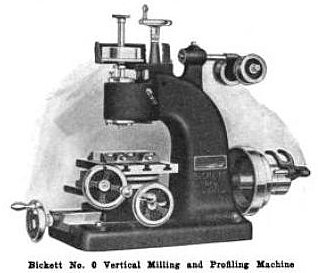|
Title: |
1917 Article-Bickett Machine & Mfg. Co., Vertical Bench Milling & Profiling |
|
Source: |
Machinery Magazine Mar 1917 pg 635 |
|
Insert Date: |
5/27/2011 9:27:55 AM |
In working out the design of a No. 0 vertical milling and profiling machine which has recently been placed on the market by the Bickett Machine & Mfg. Co., 1118 Richmond St., Cincinnati, Ohio, a departure has been made from the practice of using an adjustable knee, all adjustment being provided in the spindle head of the machine. It is claimed that this provides a more rigid table support, thus reducing vibration to a minimum and maintaining alignment at all times. This machine is especially designed for operation at high speed, and may be driven at 2500 revolutions per minute. It is adapted for such work as die-sinking, letter cutting, cam milling, splining, etc., and finds application in factories engaged in the manufacture of sewing machines, typewriters, electrical and scientific instruments, firearms, adding machines, etc.
The use of radial-thrust bearings adapts this machine for operation at the high speeds referred to, and also enables advantage to be taken of a high transmission efficiency by reducing friction losses to a minimum. These ball bearings are self-oiling and will run for a long time without requiring attention; their use has been the means of practically eliminating trouble from hot bearings. If desired, the machine can be furnished with a lever feed attachment in place of the hand-wheel and elevating screw. This attachment is convenient when rapid vertical adjustment is required, as in certain classes of profiling. In working out the design, attention has been paid to providing means for convenient operation.
The spindle is made of crucible steel, accurately ground to size. It is fitted with a No. 3 Hardlnge collet, which is held by a draw-in attachment operated from the top of the spindle. The spindle head is gibbed to the column of the machine, and the vertical adjustment is two inches, obtained by means of an elevating screw at the rear of the spindle. Two changes of speed are provided, and as mentioned, the machine may be safely driven at 2500 revolutions per minute under continuous operation. The spindle pulley is 1V4 inch wide by 4 inches in diameter; it is flanged at the bottom and provided with a belt guard. The intermediate pulleys are 2% inches in diameter and are flanged on both sides. The two-step cone pulley has steps 8 and 6 inches
in diameter; and the tight and loose pulleys are 3½ inches in diameter by 1¾ inch face width.
A handy belt shifter is provided for starting and stopping the machine. The table is 7 by 10 inches in size and has three ½-inch T-slots machined in it. This table may be rotated by means of an Acme-thread screw, which is carefully fitted to a large worm-wheel. The worm feed can be easily engaged or disengaged and is provided with means of compensation for wear. The longitudinal, transverse and vertical feed-screws are provided with adjustable dials graduated to read to 0.001 inch, and all screws have Acme threads.
The equipment furnished with this machine includes the following: one toolmaker's vise with jaws 6 inches wide by 1 inch high, with a maximum opening of 6 inches; one No. 3 Hardinge collet; one draw-in attachment; and the necessary wrenches for making all adjustments. A pedestal 26½ inches high may be furnished as a special equipment. The principal dimensions of the machine are as follows: total height of machine without pedestal, 26½ inches; width of base, 11 inches, length of base, 20 inches; distance from top of rotary table to spindle nose, 4¼ inches; maximum longitudinal feed, 6 inches; maximum traverse fee, 5 inches; maximum vertical fed, 2 inches; and weight of machine, 200 pounds. |
|
 1917 Bickett Machine & Mfg. Co., Vertical Bench Milling & Profiling Machine
1917 Bickett Machine & Mfg. Co., Vertical Bench Milling & Profiling Machine
|
|